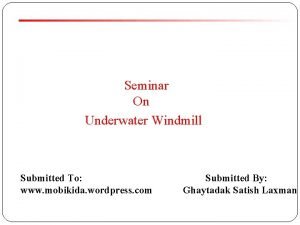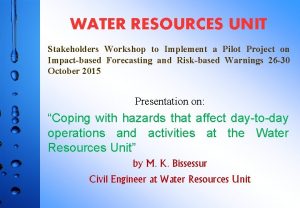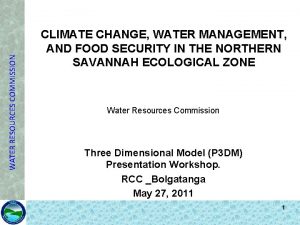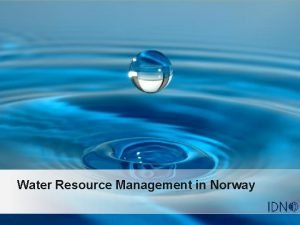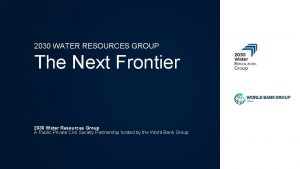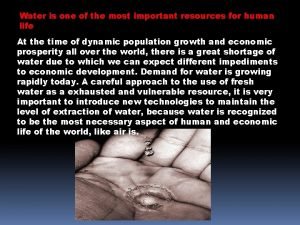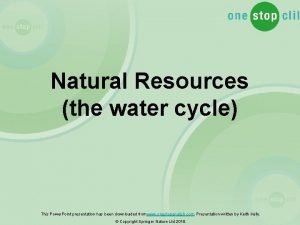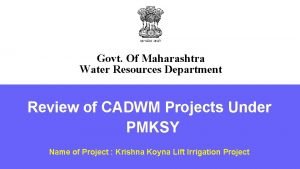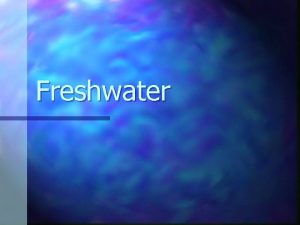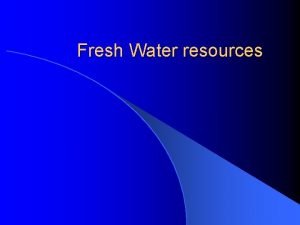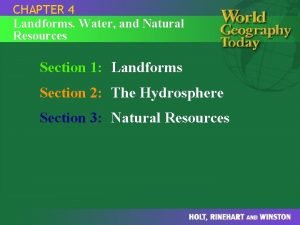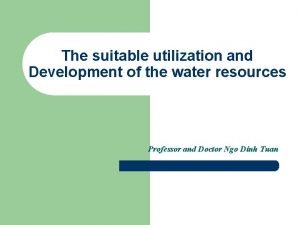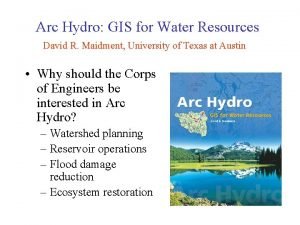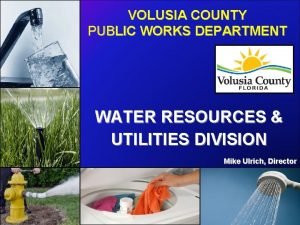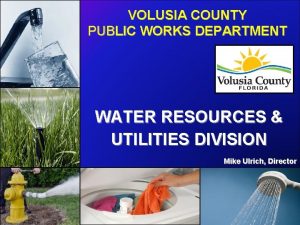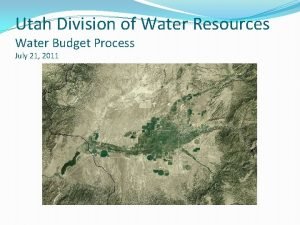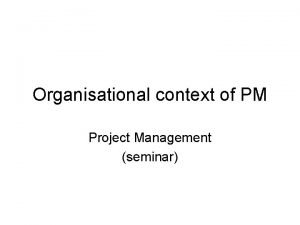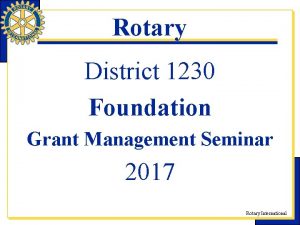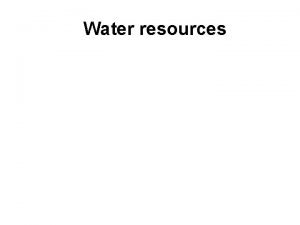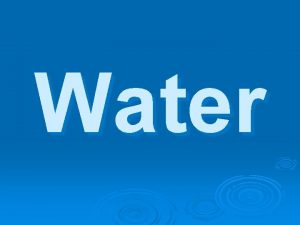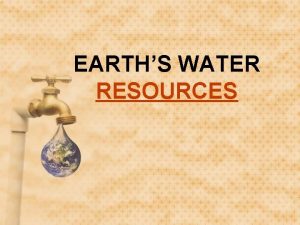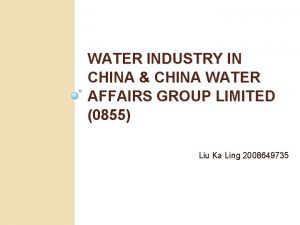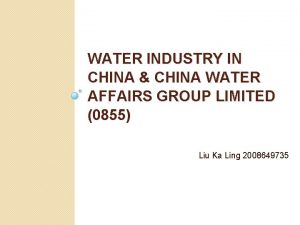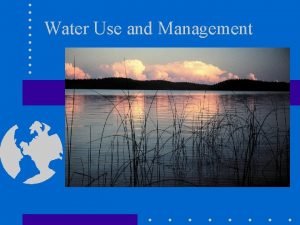China Water Resources Management Policy Seminar June 22













































- Slides: 45

China Water Resources Management Policy Seminar - June 22, 2016 Flood and Drought Management in China Ding Liuqian Director of Technical Research Center of flood control, Drought Relief and Disaster Reduction Engineering, MWR Director of Disaster Reduction Center, China Institute of Water Resources & Hydropower Research Disclaimer: The views expressed in this document are those of the author, and do not necessarily reflect the views and policies of the Asian Development Bank (ADB), its Board of Directors, or the governments they represent. ADB does not guarantee the accuracy of the data included in this document, and accept no responsibility for any consequence of their use. By making any designation or reference to a particular territory or geographical area, or by using the term “country” in this document, ADB does not intend to make any judgments as to the legal or other status of any territory or area.

Outline 1. Overview of Flood and Drought Disaster Situation 2. Introduction to Construction of Structural Disaster Mitigation Engineering 3. Introduction to Construction of Nonstructural Disaster Mitigation Engineering 4. Flood Achievements in Flood Control, Drought Relief and Disaster Reduction 5. Future challenges and countermeasures

1 Overview 1. 1 Physical geography and rainfall features Three steps terrain Pacific water vapor Indian water vapor Ø China lies in the Eurasian continent, facing the Pacific on the east and the Indian Ocean on the west. China is located in East Asian monsoon region. Ø China's terrain descends in three steps from west to east, which will influence and control water vapor when it enters into the continent.

1 Overview 1. 1 Physical geography and rainfall features Average rainfall in China 100% 90% 80% 70% 60% 50% 40% 30% 20% 10% 0% Influenced and controlled by sea-land circulation, monsoon, tropical cyclone and three steps terrain, precipitation in China is characterized by uneven spatial and temporal distribution. The precipitation decreases from the southeast to the northwest. 60%~over 80% rainfalls occur in the flood season from May to September. It is very difficult to use water resources. Maximum storm in eastern areas in different periods reaches the world record. China is one of the countries that are seriously affected by drought and flood disasters in the world. Precipitation rates of main rivers in flood season 20. 0% Percentage in flood season 80. 0% Liao River Yangtze 辽河River 22. 1% Percentage in flood season 77. 9% Pearl River 珠江 25. 0% Percentage in flood season 75. 0% 黄河 Yellow River 海河 35. 0% Percentage in flood season 65. 0% Hai River 淮河 40. 0% Percentage in flood season 60. 0% Huaihe River 长江

1 Overview 1. 2 Numerous river system, 1. 8 km continental coastline and serious flood mitigation task >10, 000 km 2 / 228 rivers/overall length: 132, 500 km River basins in China >1, 000 km 2 / 2, 221 rivers/overall length: 386, 500 km Songhua River >100 km 2/22, 909 rivers/overall length: 1, 114, 600 km >50 km 2 /45, 203 rivers/overall length: 1, 508, 500 km Liaohe River Yellow River Seven major rivers: Haihe River Yangtze River, Yellow River, Pearl River, Huai River, Hai River, Songhua River, Liao River Huai River Yangtze River Water volume of major rivers (100 million m 3) Yangtze River Pearl River Songhua Huaihe River Yellow River Liaohe River Pearl River Haihe River

1 Overview 1. 3 Flood and drought disaster characteristics --- various disaster types River basin flood Typhoon Flash flood Urban flood Ice flood Dam-break flood Agriculture drought Urban drought

1 Overview 1. 3 Flood and drought disaster characteristics --- extensive influence Flood disaster distribution in China Flash flood occurrence distribution in China Population density distribution in China The middle and lower reaches of seven major rivers and coastal plains are flood-prone areas, which covers 8% of total country’s area with the area of 800, 000 km 2. 1/2 national population, 1/3 farmland 3/4 GDP are concentrated here. The protection area of flash flood is 4, 600, 000 km 2, nearly half of national territory, with 2058 counties (72% of whole counties), ½ country’s area, 1/3 farmland 560 million population (40% of national population).

1 Overview 1. 3 Flood and drought disaster characteristics --- extensive influence Distribution of counties prone to agricultural drought in China Distribution of Seriously drought-stricken counties in China Distribution of water shortage counties caused by drought in China Among 2, 863 counties in China, 2, 025 drought stricken counties (accounting for 71% of total number of counties), including 584 seriously drought-stricken counties, 1, 400 counties with drinking water shortage caused by drought and 1, 608 agricultural drought counties.

1 Overview 1. 3 Flood and drought disaster characteristics --- high occurrence frequency Number of severe floods and droughts since 1949: over 60 times, more than once a year Inundated Wuhan in 1954 Drought stricken Liaoning in 2009

1 Overview 1. 3 Flood and drought disaster characteristics --- severe disaster losses 1950~ 2015: Flood disaster: more than 280, 000 deaths and 4266 annual average deaths; 9. 72 million hectares affected annually; 122 million houses collapsed annual average 1. 848 million houses collapsed. Drought disaster: 20. 82 million hectares affected annually; 16. 26 billion kilograms of annual average grain loss. From 2006 to 2015, the annual direct economic losses caused by flood and drought reach RMB 280. 35 billion, accounting for 71% of direct economic losses caused by natural disasters Biological disasters in agriculture, forestry and husbandry 6% Other disasters Marine disaster 7% Average 2, 803. 5 Earthquake disaster 8% Flood and drought disasters 71% Annual direct economic losses caused by flood and drought (unit: RMB 100 million )

2 Introduction to Construction of Structural Disaster Mitigation Engineering Because of the special natural geographical and climatic conditions, China must be a country seriously affected by flood and drought. Moderate standard system is the basis and fundamental guarantee for flood control, Drought Relief and disaster reduction, which haven been proved by the history of national development. Ø Dike: 414, 000 km in length, including 275, 000 km dikes at level-5 and above Jingjiang dike of Yangtze river Dike of Songhua river Dike of Yellow river Dike of Shanghai

2 Introduction to Construction of Structural Disaster Mitigation Engineering Ø Reservoirs: Total number of reservoirs : 98, 000 Large-sized reservoirs: 756 Total storage capacity: 393× 108 m 3 Three Gorge Reservoir on Yangtze River Total storage capacity: 9, 323× 108 m 3 Medium-sized reservoirs: 3, 938 Total storage capacity: 126. 5× 108 m 3 Xiaolangdi reservoir on Yellow River

2 Introduction to Construction of Structural Disaster Mitigation Engineering Ø Key flood detention areas: Total key flood detention areas: 98 Total area of flood detention areas : 3, 3700 km 2 Storage capacity of flood detention areas : 1074× 108 m 3 Jingjiang flood detention basin Dongping Lake flood detention basin

2 Introduction to Construction of Structural Disaster Mitigation Engineering Ø Sluices Total sluices: 97, 000 Large-sized sluices: 860 Medium-sized sluices: 6, 332 Sanshenggong sluice on Yellow river Bengbu sluice on Huai river

2 Introduction to Construction of Structural Disaster Mitigation Engineering Ø Irrigation areas Total number of irrigation districts: over 2, 000 Number of Irrigation districts with area more than 30, 0000 mu: 456 Irrigation area: 280, 000 mu Irrigation area of Ganfu plain in Jiangxi Canal of Jiamakou irrigation area in Shanxi

2 Introduction to Construction of Structural Disaster Mitigation Engineering Ø Water supply projects Number of rural water supply projects: 58, 870, 000 Benefitted population: 812 million Water pumping station Water supply project

2 Introduction to Construction of Structural Disaster Mitigation Engineering Ø Large water diversion projects Both east Route and middle route of the South to North Water Transfer Project have been put into use, with 3000 km main lines and designed amount of diversion water of 18. 27 billion m 3 per year. They effectively alleviate the water shortage in the north and serious ecological deterioration situation in Baiyangdian before water diversion Baiyangdian after water diversion Transferring water from the Yellow river to Tianjin through Hebei province

2 Introduction to Construction of Structural Disaster Mitigation Engineering The construction of engineering system provides fundamental guarantee and plays an important role in flood control and drought relief. Ø Large rivers’ capacity to withstand flood: Main reaches of large rivers have the ability to withstand the biggest floods since 1949 Ø Middle and small rivers’ capacity to withstand flood:They can withstand common flood Dike of Yellow river’s mainstream Medium/small rivers harness project in Jiangxi

2 Introduction to Construction of Structural Disaster Mitigation Engineering Ø Urban flood control capacity: Generally constructed to control the flood occurred once every 50 -200 years Ø Key sea embankments: Generally constructed to control the flood occurred once every 50 -100 years Dike of Wuhan city Sea embankment in Zhejiang province

2 Introduction to Construction of Structural Disaster Mitigation Engineering Ø People’s domestic water use both in cities or rural areas can be guaranteed when severe droughts occur. Ø Water use for agriculture, industry and ecology can mostly be guaranteed when medium droughts occur. Domestic water use Sprinkle irrigation

3 Introduction to Construction of Non-structural Disaster Mitigation Engineering Non-structural system is an indispensable part and important guarantee for flood control, drought relief and disaster reduction. Non-structural system has and will play an increasingly important role in flood control, drought relief and disaster reduction. Non-structural system has great potential. Ø Legislation system Regulation system of flood control and Drought Relief has been established. A series of laws or regulations have been enacted and implemented, including Water Law, Flood Control Law, Flood Prevention Regulation, Drought Relief Regulation etc.

3 Introduction to Construction of Non-structural Disaster Mitigation Engineering Ø Technical standard system More than 30 standards closely related to flood control, Drought Relief and disaster reduction, involving in prevention and control, planning, design, forecasting, division, prediction scheme, disaster evaluation etc. 1 Standard for flood control GB 50201 -2014 2 Code formulation of flood control planning SL 669 -2014 3 Standard for waterlogging control SL 723 -2016 4 Standard for hydrological information and hydrological forecasting GB/T 22482 -2008 5 Regulation for calculating design flood of water resources and hydropower projects SL 44 -2006 6 Safety rules of lifting appliances for water resources and electric power construction SL 428 -2008 7 Guidelines formulation of reservoir regulation rules SL 706 -2015 8 Design specification of reservoir GB/T 50587 -2010 9 Compilation guide of flood control operation plan SL 596 -2012 10 Regulation for simulation of dam-break flow SL 164 -2010 11 Guidelines for emergency preparedness plan of reservoir dam safety management SL/Z 720 -2015 12 Design Specification for Flood Detention Retarding Basin GB 50773 -2012 13 Guidelines for flood storage and detention area preplan SL 488 -2010 14 Guidelines for assessment of flood control risk SL 602 -2013 15 Compilation guidelines for flood impact assessment report SL 520 -2014 16 Flood disaster assessment SL 579 -2012 17 Flood Risk Mapping Guidelines SL 483 -2010 18 Technique guideline for emergency disposal of landslide lake SL 451 -2009 19 Standard for classification of risk grade of landslide lake SL 450 -2009 20 Guideline on the Compilation of Emergency Preparedness Plan for the Prevention of Flash Flood Disaster SL 666 -2014 21 Guidelines on the design of monitoring and warning systems for flash flood disaster prevention SL 675 -2014

3 Introduction to Construction of Non-structural Disaster Mitigation Engineering Ø Technical standard system 22 Guideline of emergency preparedness plan for typhoon prevention SL 611 -2012 23 Standard of classification for drought severity GB/T 32135 -2015 24 Standard of classification for drought disaster SL 663 -2014 25 Compilation guidelines for drought response plan SL 590 -2013 26 Classification for drought information SL 546 -2013 27 Code for design of levee project GB 50286 -2013 28 Guidelines for levee safety evaluation SL/Z 679 -2015 29 Code for design of sea dike project GB/T 51015 -2014 30 Specification of exploration for dike hidden trouble SL 436 -2008 31 Design standard of flood control project in city GB/T 50805 -2012 32 Code for design of river regulation GB 50707 -2011 33 Code of practice for compilation of river sand-mining planning SL 423 -2008 There are 140 technical standards related to hydrological and hydraulic information, playing an important role in the construction of flood control engineering and non-engineering measures in a scientific and standardized manner.

3 Introduction to Construction of Non-structural Disaster Mitigation Engineering Ø Administrative structure Organization and command system at three levels of national, basin and local · unified command · interdepartmental communication · identified responsibility · cooperation between army and civilian Flood Control and Drought Relief Agency of seven major river basins State Flood Control and Drought Relief Headquarters (SFCDRH) 22 member organizations • Propaganda Provincial flood control and drought relief agencies Municipal flood control and drought relief agencies County-level flood control and drought relief agencies Department of the Central Committee of CPC Provincial government authorities and military • NDRC • Ministry of Civil affairs • Ministry of Finance Municipal government authorities and military • Ministry of Lands and Natural Resources • Ministry of Agriculture County-level government authorities and military • China Meteorological Administration • Military and armed force etc Chart of Flood Control and Drought Relief System

3 Introduction to Construction of Non-structural Disaster Mitigation Engineering Ø Responsibility system The chief administrative officials of people's governments at all levels shall assume overall responsibility for the work of flood control and drought management. Make public announcement about chief officials, strengthen responsibility oversight and accountability. Flood control and Drought Relief responsibility system Chief administrative official responsibility system Responsibility system at all levels Responsibility system department Responsibility system on post Responsibility system in technical term Flood control and Drought Relief responsibility system

Preplan for Drought Relief Preplan for water volume diversion Preplan for emergency rescue Preplan for personnel transfer for avoiding disaster Preplan for typhoon and storm defense Preplan for flash flood defense Preplan for application of flood storage and retention area Preplan for urban flood control Reservoir flood scheduling scheme River flood defense scheme and flood scheduling scheme 3 Introduction to Construction of Non-structural Disaster Mitigation Engineering Ø Preplan system Kinds of prepared plans have been formulated both at national and local level. Emergency preplan for flood control and Drought Relief

3 National flood control and Drought Relief command system Ø Introduction to Construction of Non-structural Disaster Mitigation Engineering Data collection system Historical flood Communication system Forecasting and early warning Project scheduling Consultation and decision Decision support system Historical materials State variables and parameters base Data query and indexing Document management and indexing Work Forecasting Model Method Base Optimization algorithm Model Rating System human-computer Interactive System Real-time Flood Forecasting and Early Warning Release System Data Processing System Database Firewall Tropical cyclone Network system Data Processing Module Substation Flood Control Consultation System Real-time flood Real-time Flood Forecasting System Data input Drainage basin Real-time rainfall Engineering data Central office National office Members of National Flood Prevention Headquarter Province (District municipality ) Region municipality

3 Introduction to Construction of Non-structural Disaster Mitigation Engineering Ø Guarantee system Various disaster rescue teams by combining people with professionals or military: more than 10 million of people PLA, army police force and professional rescue teams: over 300, 000 people Reserved materials for flood control and drought relief: over 11 billion Yuan P. L. A. ’s emergency flood rescue force Flood rescue rehearsal Reserved materials for flood control

3 Introduction to Construction of Non-structural Disaster Mitigation Engineering Ø Emergency management Keep watch Emergency transfer Consultation Emergency rescue Emergency response Post-disaster recover

4 Flood Achievements in Flood Control, Drought Relief and Disaster Reduction Flood control benefits Since 1950 s: Flood mitigation benefit: RMB 4600 billion; Reduced farmland inundation: 0. 18 billion hector; Reduced grain losses: 0. 76 billion tons; Greatly reduced property collapse; Significantly reduced fatality. House collapse (10, 000 houses) Average 1848 thousand per year from 1950 to 2015 The number of deaths caused by flood disaster The number of death caused by flood Total 280, 000 people and above, annual average 4, 266 people from 1950 to 2015, showing descending trend as the whole 1950~ 2015,annual average 4, 266 people in 66 years Annual average 2, 450 deaths in the recent 30 years Annual average 1, 761 deaths in the recent 20 years Annual average 1, 067 deaths in the recent 10 years Annual average 554 deaths in the recent 5 years Annual average 319 deaths in 2015, minimum average level in history

4 Flood Achievements in Flood Control, Drought Relief and Disaster Reduction Flood control benefits 1990 -2015: Direct economic loss increased linearly by 7. 4%, nearly half of GDP increase; The ratio decreased gradually: from 0. 91% 20 years ago to 0. 25% at present. Direct economic losses caused by flood (Unit: RMB 100 million) As the whole, showing descending trend with annual average of RMB 13. 985 million Increase rate 7. 45 ratio in GDP (%) As the whole, showing descending trend with annual average of 1. 31%

4 Flood Achievements in Flood Control, Drought Relief and Disaste Reduction Flood control benefits Since 2010, based on the construction of flash flood prevention projects, population fatality induced by flash flood was greatly reduced by 680 deaths in average. Before implementation of flash flood disaster control project Annual average 1, 079 deaths After implementation of flash flood disaster control project Annual average 400 deaths Decrease annual average by 680 deaths

4 Flood Achievements in Flood Control, Drought Relief and Disaster Reduction Drought Relief benefits The drinking problem of 231. 9 million population annually was solved, reducing irrigation areas of 0. 43 billion mu and grain losses of 39. 02 million tons. The population suffered from drinking shortage and direct economic loss due to drought were reduced step by step. Population suffering from water shortage caused by drought (Unit: 10, 000 people) As the whole, showing descending trend with annual average of 25, 959, 000 people Direct economic losses caused by drought (Unit: RMB 100 million) As the whole, showing descending trend with annual average of RMB 96. 65 billion Percentage in GDP As the whole, showing descending trend with annual average of 0. 26%

5 Future challenges and countermeasures Ø Climate change will increase extreme precipitation and flood risks Compared with 1986 -2005, under Scenario RCP 4. 5, extreme precipitation, 5 -day maximum precipitation will increase by 25% and 11%, storm frequency will increase by 58%, and flood and drought risk will also increase largely. High risk areas include middle east, southeast coastal areas, northeast capital cities and parts in Shaanxi and Shanxi provinces. Increased rate of extreme precipitation Distribution of flood risk levels in China at the end of 21 st century under the background of RCP 8. 5 Increase rate of maximum continuous precipitation in five days

5 Future challenges and countermeasures Ø Rising of sea level will increase flood risks in coastal areas From 1980 to 2005, the increasing rate of sea level is 3. 0 mm/a, higher than global average, and continue to increase in the future. Flood drainage difficulties in coastal cities will increase, making flood control capacity of present works lower, typhoon and tidal disaster losses larger, and flood risks greater. Name 2015 Future 30 years Bohai Sea 94 mm +65~ 155 mm Huanghai Sea 91 mm +75~ 165 mm East China Sea 96 mm +70~ 160 mm South China Sea 82 mm +75~ 165 mm Sea level Linear trend 1980~2015 Changes in sea level in coastal areas in China 122 mm

5 Future challenges and countermeasures Ø Extreme disaster risks of typhoon, storm and tidal will increase Area index Future: Frequency of typhoon will decrease, while landing ratio and intensity will increase, as well as typhoon, storm and tidal intensity and extreme flood disaster risks. Intensity index 1951~2011 Frequency of generation and landing of Northwest Pacific and South China Sea typhoon West extension index 1961~2011 Changes in West Pacific subtropical highpressure characteristics variation 1951~2011 Ratio of typhoon landing in China

5 Future challenges and countermeasures Ø Climate change in future will increase the range of high risk to drought The annual precipitation in China will keep increasing in the future of the 21 st century. The average growth rate at the end of the century will be 2%~5%, where the average growth rate of the northern area will be 5%~15%. Drought will be mitigated to a certain degree and the drought frequency will decrease in the overall. However, the frequency of high temperature and extreme drought events will increase. The north China, east China, central of northeast and southwest will be exposed to high risk to drought. In the late of 21 st century, the range of high drought risk will increase significantly. Maximum number of continuous drought days Changes in China’s maximum number of continuous drought days under the background of RCP 4. 5 compared with 1985~2005 Distribution of drought disaster risk levels in China under the background of RCP 4. 5 in the future

5 Future challenges and countermeasures Ø Economic and social development set higher requirements for flood control and drought relief Urbanization, rapid development of coastal regions, poverty elimination in mountainous areas, construction of ecological civilization and beautiful China and realization of human-oriented concept and well-off society have set higher requirements for flood control and drought relief. The tasks in flood control and drought relief will be still heavy in future. Rural population Urban population Urbanization rate

5 Future challenges and countermeasures Climate change promotes extreme development of precipitation and increases frequency, intensity and scope of extreme precipitation. Coupled with rising sea level, impact caused by urbanization and repaid economic and social development, the risk of flood and drought disasters increases. The main problems are: ØNot all rivers reach the planned standard for flood control. There is large uncertainty for superstandard floods. ØMedium and small rivers and flash flood disasters are serious and have become a weak point in flood control. ØUrban flood disasters are highlighted and have big impact. ØCoastal storm surge defense with low standard. ØDikes and reservoirs have many potential safety hazards. ØThe contradiction between flood control and flood resource utilization is highlighted. ØThe capacity for dealing with severe drought incidents still needs to be improved. ØNon-structural measures are still lacked and risk management needs to be improved.

5 Future challenges and countermeasures Countermeasures: In addition to taking emission reduction measure and reducing man-made temperature rise, follow “No Regrets” principle, continue to construct and improve appropriate standards and coordinated structural and non-structural engineering systems, implement and enhance the integrated management on flood and drought risks. Ø Structural engineering measures ü Considering the impact caused by climate change, study and review the changes in design conditions and standards, make adjustment and standard construction, achieve the defense standards that are planned and matched with the level of economic and social development ü Strengthen the construction of weak links in engineering Strengthen the construction of non-qualified large river projects, urban flood control projects, medium and small river governance projects, sea embankment projects, rivers and lakes connection projects, basin control projects, drought relief infrastructure and emergency water supply projects. Meanwhile, improve the operation and maintenance of the projects that have been constructed, make sure the safety and function standards are not lowered.

5 Future challenges and countermeasures Countermeasures: Ø Non-structural engineering measures Ø Improve policy and regulation system, create innovation in institutional mechanisms for flood management Including four levels: laws, administrative regulations, work rules and technical standards Based on the needs in new situation, timely review and improve unreasonable issues and construct the much-needed projects, such as: Establish flood risk notification system: Finish flood risk mapping and release it to the public, enhance social awareness to risks, promote social management and involvement in flood control, drought relief and disaster reduction; Strengthen flood impact evaluation and land use management, regulate human activities and reduce man-made disasters; Establish flood insurance system and effectively share and avoid risks etc. Ø Continue to strengthen and constantly improve the construction of national flood control and drought relief command system Strengthen the capacity building in monitoring forecasting and early warning, improve timeliness and accuracy of rainfall and drought forecasting and early warning as well as engineering system scheduling, improve the capacity and level of emergency decision-making and command.

5 Future challenges and countermeasures Countermeasures: Ø Non-structural engineering measures Ø Improve various emergency preplans Strengthen training, improve operability and practice effectiveness, reduce the losses caused by disasters, reduce the risk of heavy impact on economic and social development caused by extreme disasters. Ø Strengthen scientific and technological support Enhance the interaction of human activities and evolution of natural system, and the study of impact on flood and drought disasters caused by climate change; Strengthen the study on theories, strategies and application technologies about flood and drought disaster risk management, and improve the scientific and technological levels in the sectors of planning, construction, operation, management and evaluation; Focus on integrated multi-disciplinary study and improve international communication and cooperation etc.

5 Future challenges and countermeasures Key research directions u Monitoring, forecasting, early warning, adjustment and control of flood disasters in river basins Ø Key technologies and instrumentation used in monitoring storms and floods Ø Technologies supporting river flood forecasting and integrated optimization of scheduling decisions Ø Desktop deduction system used for superstandard flood disasters occurring in large rivers Ø Forecasting methods and key technologies used for accurate monitoring of local heavy rainfall in mountainous regions Ø Simulation technique for law of runoff yield in small watersheds Ø Flash flood dynamics forecasting and early warning technology Ø Flood vulnerability assessment and monitoring technology Ø Integrated management on flood disaster risks in watersheds u Monitoring, forecasting, early warning and integrated response to urban flood disasters Ø Urban rainwater flood characteristics and flood simulation technology Ø Technology supporting urban flood monitoring, early warning and decision Ø Integrated planning technology for rainwater flood management and construction of "Sponge City" Ø Study on integrated management on urban flood disaster risks

5 Future challenges and countermeasures Key research directions u Monitoring, forecasting, early warning and risk management on drought disasters Ø Key technologies for monitoring and forecasting of drought disaster Ø Key technologies for assessment, adjustment and control of agricultural drought risk dynamics Ø Key technologies for early warning of hydrological drought in rivers, lakes and reservoirs Ø Key technologies for emergency water diversion for ecological drought Ø Integrated management on drought disaster risk u Technologies and equipment used for flood control, emergency rescue and drought relief Ø Technologies and equipment used for hidden hazard detection and safety assessment Ø Technologies and equipment used for dike emergency rescue Ø Technologies and equipment used for barrier dam emergency rescue Ø Key technologies and equipment used for ice flood emergency rescue Ø Key technologies and equipment used for emergency drought relief

Thank you! Looking forward to discussion and exchange!
 Water and water and water water
Water and water and water water What is transforming resources
What is transforming resources Fixed resources and variable resources
Fixed resources and variable resources Renewable vs nonrenewable resources worksheet
Renewable vs nonrenewable resources worksheet Underwater windmill wikipedia
Underwater windmill wikipedia Water resources unit mauritius
Water resources unit mauritius Conclusion on water management
Conclusion on water management Norway water resources
Norway water resources Sabah water resources enactment 1998
Sabah water resources enactment 1998 Explain important of watershed management
Explain important of watershed management 14.2 uses of freshwater
14.2 uses of freshwater Pollution of water is responsible for
Pollution of water is responsible for 2030 water resources group
2030 water resources group Hakaluki haor fill in the blanks
Hakaluki haor fill in the blanks Water is one of the most important resources
Water is one of the most important resources Natural resources water cycle
Natural resources water cycle Maharashtra water resources department
Maharashtra water resources department Water resources list
Water resources list Problems of water resources
Problems of water resources Chapter 4 landforms water and natural resources
Chapter 4 landforms water and natural resources Conclusion of water resources
Conclusion of water resources Fish map
Fish map Air and water resources lesson 4
Air and water resources lesson 4 Ninety-seven percent of the world’s water resources are
Ninety-seven percent of the world’s water resources are Volusia county water and sewer
Volusia county water and sewer Volusia county water
Volusia county water Division of water resources utah
Division of water resources utah Oregon water resources department
Oregon water resources department Dental unit water lines policy
Dental unit water lines policy Define seminar in nursing management
Define seminar in nursing management Performance management seminar
Performance management seminar Project management seminar
Project management seminar Conflict management seminar
Conflict management seminar Rotary district 1230
Rotary district 1230 Chicago management training seminar
Chicago management training seminar China international fund management
China international fund management 30 days has september
30 days has september Flax exam
Flax exam June 2010 physics regents answers
June 2010 physics regents answers June 2005 calendar
June 2005 calendar Mitsl
Mitsl Good morning 1 june
Good morning 1 june Corn be heavy soon meaning
Corn be heavy soon meaning June 2010 chemistry regents
June 2010 chemistry regents Welcome june blessings
Welcome june blessings English language paper 1 june 2021
English language paper 1 june 2021




